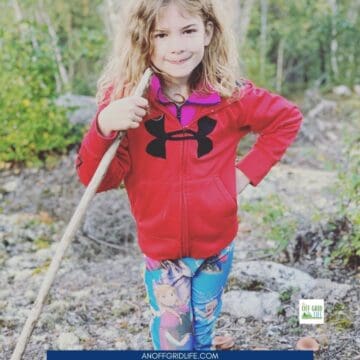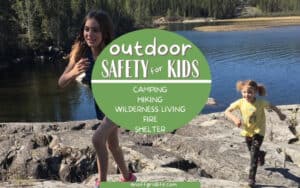Forest schooling, also known as bush schooling, involves teaching kids basic outdoor skills, in an outdoor setting. Think of it as taking children’s class outside. Continue reading to learn more about forest schools, how to get started, and how they benefit children's learning and development.

What is Forest Schooling?
Forest schools as a style of education began during the 1950s in Denmark. However, they have become increasingly popular in Europe and North America since the 1990s. In fact, my younger sisters enjoy forest school as part of their homeschooling off the grid day.
Forest schooling allows kids to stay active and learn to respect their environment, peers, and themselves. For young children who would regularly attend daycare or pre-school, forest schools provide a unique alternative to improve their development and education.
Some people mistakenly think forest schooling is just a fancy term for letting your kids play in the woods. But there’s actually a lot more to it. Every forest school instructor teaches differently, but many follow a semi-structured lesson plan, and may include wilderness survival skills, plant identification, and even birdwatching.
Depending on the state or province you live in, some local forest schools will follow aspects of the local educational system. Forest schools often incorporate a variety of traditional academic subjects, such as math, science, history and even literature into their lessons. This creates a hybrid educational program.
Who Benefits from Forest Schooling?
Kids of all ages benefit from forest schooling in some way, but it remains most popular for children under the age of 10. Numerous studies have shown that outdoor play has many physical, mental, and emotional benefits for children, including building self-confidence.
For children with developmental issues, forest schools give them a chance to learn in a less structured environment. This allows them to adapt and learn at their own pace. Learning outdoors also helps hone motor skills, and teaches children to be more independent.
Children who learn best with a "hands-on" method flourish in outdoor settings. Furthermore, forest schooling helps children build a positive relationship with nature and their environment.
What Life Skills Children Learn in the Forest
Forest schooling gives children the chance to learn a wide range of skills outside of the classroom. Some of the practical skills include:
- Math
- Plant and animal identification
- Motor skills with small tools
- Wilderness living skills
- Nature lessons
- Foraging
Depending on your child’s skill level, you can also teach basic map reading and knot-tying skills as well.
As with most learning, the applicable lessons for children depend on their age. Older children can be taught advanced outdoor survival skills like fire starting and shelter building. Outdoor scavenger hunts present a great opportunity to get younger children interested and exploring the forest.
Every forest school has a different curriculum. You can add or remove different lessons depending on your child's interest and skill level. Take a look at some of the different forest schools in Canada. Take ideas from these to create your own forest homeschool tailored to your own kid’s specific interests.
Add Forest Schooling to Your Homeschool Day
In an age of technology and video games, getting your kids outside will keep them active and interested in the nature surrounding them. They will not only just learn about the outdoors, but about themselves too. Building problem-solving skills and an independent learning habit will give them productive habits for the rest of their life.
To get your youngest kids engaged in the forest schooling mentality, try making a wilderness survival kit together. You can find most of the materials for these kits around your house, and it will get your kids excited to try them out in the forest.
Create new lessons for your kids by including specific items in the survival kit, such as a compass, paracord, or signaling mirror. Give your kids some guidance on what each item is for, and see what they end up doing. Letting your kids try new things and explore different ideas on their own will help foster creativity and problem-solving skills.
Get Outside as a Family
If you don’t have the time or resources to make your own wilderness kits, try signing up for Think Outside Boxes. These outdoor living subscription boxes for families come each month and always include different items and tools to get kids outside and exploring.
They include everything from science lessons to nature journaling. Each box also includes pamphlets and written lessons explaining how to use each item and what you will learn from it.
Don't think Forest Schools are only for those of us living off the grid or out in the country. No matter where you live, you'll find different Forest School lesson ideas, you just have to get a little creative sometimes. For example, if you live in a town or city, try teaching your children some useful urban foraging skills.
Forest schools might just sound like kids playing in the woods, but they have far more benefit and structure than a standard “play-time”. By providing your kids with a basic lesson structure and allowing them to thrive in an outdoor environment, you’re setting them up for future success.
The life lessons and skills children learn outdoors will help them be more independent while fostering their creativity and motor skills. If you need more inspiration for lesson ideas, check out this guide by Forest School Canada. This free PDF has a lot of useful information on lesson plans and different approaches to learning.
Remember that even the most basic forest school lessons will benefit your children. So start brainstorming some lessons and get your kids outside.







